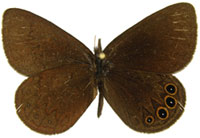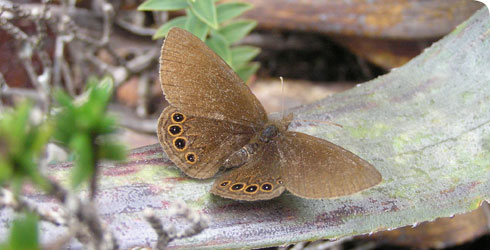Idioneurula donegani
This new species was discovered recently in one of the highest peaks of Colombia’s Serranía de los Yariguíes. To explore these mountains, the Museum’s butterfly curator Blanca Huertas and her team were dropped by helicopter on an isolated peak at 3,000 metres above sea level.
This exploration and many new species discoveries help with the creation of a national park by the Colombian government.
The type specimen of the new species remains in Colombia’s main scientific collections in Instituto Alexander von Humboldt.
Species detail
All known species of Idioneurula are rather similar in appearance. They are small-medium sized, plain brown butterflies with a variable number of ocelli on their hind wings. Patterns on the ventral hind wings vary considerably intraspecifically in some species.

All known species of Idioneurula are similar in appearance. © B Huertas/Proyecto YARE/CLP
Idioneurula species are found mainly in high elevation habitats (páramos) of Colombia and Venezuela, but their complete range is not known due to a lack of collecting initiatives in high elevations in the region (which itself is partially due to historical security concerns).
It is possible that other species in the genus could remain undiscovered (e.g. in the Serranía de Perijá).
Host plants also remain unknown for some species, although Poaceae is the usual host plant of Satyrinae (DeVries, 1987; Ackery 1988; Robinson et al. 2002).
Idioneurula are small to medium sized butterflies with a rather triangular-shaped forewing, plain brown coloured wings, no markings on the dorsal forewing, at least one ocellus on the lower border of the dorsal hindwing, such ocelli generally black with a yellow or orange border and white centre spot, no marked sexual dimorphism high elevation distribution in the East Andes.
-

Distribution
It is believed that Idioneurula donegani may be endimic to Serranía de los Yariguíes. Find out more about the distribution of this butterfly.
-

Etymology
Learn about the origins of the name 'Idioneurula donegani' and the person it is named after.
-

Molecular analyses
Find out about the efforts underway to determine the sister species of Idioneurula donegani and what experts currently believe is the sister species.
-

Conservation
Despite there being insufficient data to make official conservation assessments of Idioneurula donegani, there are a number of threats suggesting that conservation efforts are necessary for this species. Find out more about the conservation of Idioneurula donegani.
Images

Idioneurula donegani is mainly found in páramos (high elevation habitats).
© B Huertas/Proyecto YARE/CLP
All known species of Idioneurula are similar in appearance.
© B Huertas/Proyecto YARE/CLP
Idioneurula donegani is found in low vegetation with spiny plants.
© B Huertas/Proyecto YARE/CLP
Conservation of the páramo habitats that Idioneurula donegani is endemic to is necessary for this species.
© B Huertas/Proyecto YARE/CLP
The epithet of Idioneurula donegani is dedicated to Thomas Michael Donegan.
© B Huertas/Proyecto YARE/CLP
There is insufficient evidence at present to determine the sister species of I. donegani.
© B Huertas/Proyecto YARE/CLP
